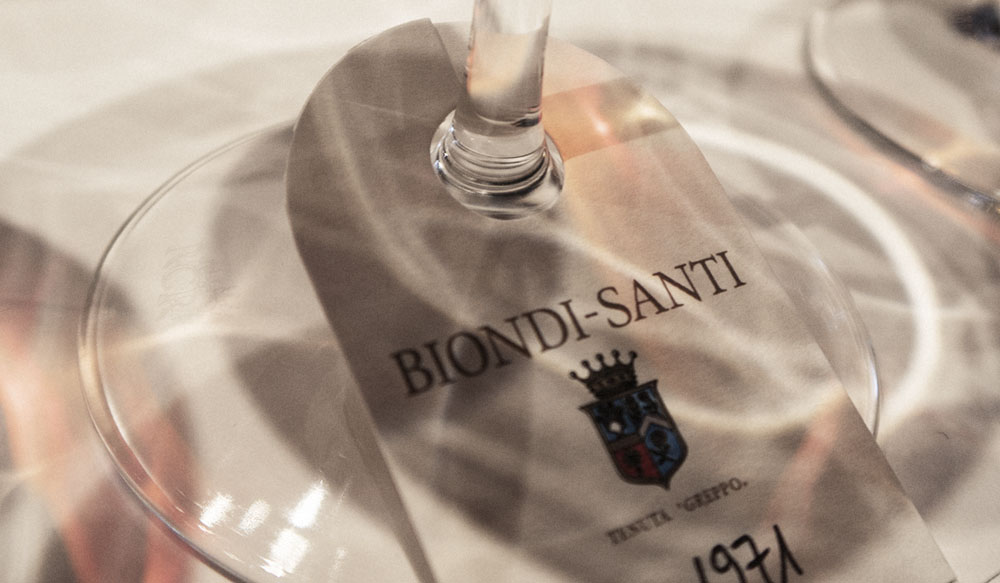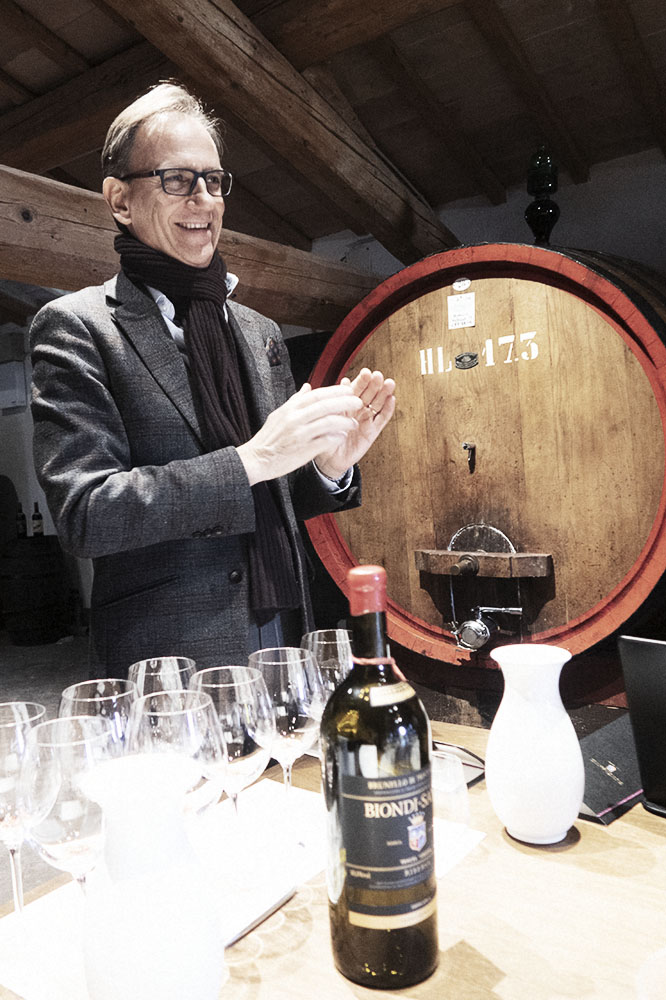
You can’t have Brunello without Biondi-Santi
By Michaela Morris
Brunello and Biondi-Santi are analogous to the romantic connection between love and marriage. You can’t have one without the other.
Credited as the inventor, Ferruccio Biondi-Santi was the first to label his wine Brunello di Montalcino in the 1888 vintage. Made from 100% Sangiovese, it emulated the wines his grandfather, Clemente crafted before him. The powerful dry red intended for long ageing was an anomaly in a zone that was renowned for sweet white wine. A handful of local producers began making wine in the same vein but even when the DOC of Brunello di Montalcino was founded in 1966, there were only 25 producers. Biondi-Santi had remained a linchpin and Ferruccio’s son Tancredi, a renowned oenologist, was called upon to draw up production guidelines.
When Tancredi passed away suddenly in 1970, his son Franco Biondi-Santi took the reins of the family’s Greppo estate. Born in 1922, Franco was over 50 years old at the time and had been working in the cellar alongside his father since the end of the Second World War. “He was a fully-grown man with his own opinions,” says Lene Bucelli, Marketing & Communication Manager for Biondi-Santi. “He had ideas of what to do differently than his father.”
Notably he reduced ageing in wood for the estate’s Riserva from 48 to 36 months allowing for a longer refinement in bottle. He also introduced temperature control and is famous for his clonal selection work. After studying 40 different clones of Sangiovese at Tenuta Greppo for over five years, he identified Biondi Santi’s BBS11 clone, which was officially registered in 1978.
Despite his innovations at the estate, Franco preserved the overall philosophy of his father and grandfather. He was considered a traditionalist and continued ageing his wine in Slavonian oak botte even when small French barriques became fashionable in Tuscany. His style was unwavering – never flashy. He crafted wines that stood the test of time and favoured, in Franco’s own words, “wines that are not too smooth, but that scratch a bit as they pass down the throat. Wines that reflect the tradition of a local area; wines that do not copy anyone.”
Franco became known as the gentleman of Montalcino. Even as the denomination swelled to upwards of 200 producers, he remained an iconic figure making benchmark wines until his death in April 2013. His last wine, the 2012 Brunello di Montalcino Riserva, was released in March of this year. In commemoration, the Biondi-Santi estate organized an historical vertical for a small group.
The tasting included eight Riservas to provide a snapshot of Franco’s life as winemaker at Biondi-Santi. Since Biondi-Santi’s existence, only 39 Riservas have ever been produced. Twenty-four of these were made by Franco. Starting with the 2010 vintage, we worked our way backward through eight wines spanning five different decades. The wines hailed from a range of hot and cool vintages but were all selected as examples in which Franco’s style was particularly evident. The penultimate was 1971, Franco’s first vintage in charge of the cellar. Next to this, and concluding the vertical, was the 2012. A poignant juxtaposition.
The two wines from the 70s were particularly stunning. Both bottles had been topped off (with wine from the same vintage) and recorked during their resting period in the estate’s library. This ‘ricolmatura’ program was initiated in 1927 for Biondi-Santi’s Riserva and continues today.

Conversely, the bottle of 1983 had not been refilled and was the only wine of the tasting that showed a little weary. As for the 2012, this is a legendary wine at the beginning of its life.
Austerity and freshness are often used to describe Franco's wines. These traits are particularly surprising – and welcome – in warmer vintages where a more forward, even evolved wine might be expected. It is in these vintages that Biondi-Santi soars above many of its peers. I did not have the opportunity to meet Franco, but I imagine him to have been a cultured, disciplined and somewhat stern man. His wines have a precision and focus that hint at a certain rigour. Yet they speak equally of Tuscany's rustic, enticing countryside. Above all, they hold you in awe.
Closing the chapter on Franco's tenure is accompanied by some nostalgia. Like many things in the world today, the future of the estate will inevitably be different than the past. In December 2016, luxury company EPI (owned by Christopher Descours) purchased a majority stake in Biondi-Santi. While Franco's son Jacopo and grandson Tancredi are still involved, the highly respected Giampiero Bertolini (formerly of the Frescobaldi group) was named CEO in 2018 and the estate's new Technical Director is agronomist Federico Radi. While Radi did not work with Franco, he did spend a number of years learning from another Sangiovese master – living legend Paolo de Marchi at Isole e Olena in Chianti Classico. Bertolini and Radi led the tasting.
"We aren't mounting a revolution; we are doing an evolution," says Bertolini describing the investment under the new ownership. This includes a parcellation project with Chilean superstar soil consultant Pedro Parra to bring more precision to the blending of Biondi-Santi's Rosso, Brunello and Riserva. "It is the same philosophy and approach that Biondi-Santi has had for the last two centuries."
Nevertheless, it is the start of a new era.
Biondi-Santi Vertical Tasting
2010 Biondi-Santi, Brunello di Montalcino Riserva
In this highly regarded vintage, Franco achieves the elusive balance of Sangiovese's tangy acidity and sandy tannins. Gorgeously pure and youthful, the nose offers fennel, fresh sweet earth, iron and wild cherry. The fruit is powerful, yet the wine remains light on its feet. Red cherry, rose and mint persist on the finish. While not unapproachable now, this promises to be even more expressive in a couple of years, and will continue to drink well for another 15 more.
2006 Biondi-Santi, Brunello di Montalcino Riserva
Federico Radi calls this a beautiful 'Brunella' describing it as a 'feminine' expression from Franco. It demonstrates the textural side of Sangiovese and has a balsamic edge of rosemary and thyme. The structure bears Biondi-Santi's signature austerity though the tannins are just a touch dry and green. It speaks to the cool finish of 2006. Best over the next dozen years.
1997 Biondi-Santi, Brunello di Montalcino Riserva
In this notoriously warm vintage, Franco likely started harvesting at the beginning of September as he was very focused on preserving acidity and aromas. Still, it is one of few vintages that the Riserva reached 14% alcohol. Despite showing some evolving sous-bois notes, this is still extraordinarily fresh with savoury heady scents and a distinct meatiness. Grippy, chewy tannins will help keep this intact for another 15 years.
1995 Biondi-Santi, Brunello di Montalcino Riserva
The cool, rainy summer lead to an atypically late harvest for Franco. While he usually stated picking within the first half of September, in 1995 he waited until October 3rd, benefiting from the improved conditions in early autumn. Initial tea and game nuances making way for blood orange. The palate is dense yet only just ripe with an underlying juiciness and a seemingly endless finish. Tannins come across as stern but will give backbone for at least another decade.
1983 Biondi-Santi, Brunello di Montalcino Riserva
One of the last vintages before Biondi-Santi's extensive replanting mid-decade, 1983 was a warm year and harvested early. While Franco started destemming grapes in the 80s, it is possible that the 1983 included some stems. Within the context of the vertical, this presented as the most evolved. Subtle coffee, chestnut and powdered tobacco are joined by a distinct nuttiness on the palate. Drink up.
1975 Biondi-Santi, Brunello di Montalcino Riserva
In 1975, winemaking was markedly different than it is today. Here the grapes were likely not destemmed, there was no temperature control and the wine may not have even gone through malolactic fermentation. Yet this is remarkably clean and precise. Notes of polished wood, tea, dried florals and earth waft from the glass. Rather gritty in texture with bracing acidity accentuating the tannins make this rustically charming. Drink over the next five years.
1971 Biondi-Santi, Brunello di Montalcino Riserva
This is still very much alive and kicking as well as fascinating and exotic. Notes of mushroom and moss meet bitter cocoa, pressed violet and dried spices. Very stern, thrilling acidity gives structure as the tannins have softened but there is still a concentrated core with incredible staying power.
2012 Biondi-Santi, Brunello di Montalcino Riserva
The 2012 vintage was among the hottest and driest summers of this century yet Franco's last Riserva is not lacking in vibrancy, energy or aromatic expression. Captivating fragrances of spring flowers, blood orange peel and intense red cherry echo on the palate, which is full and concentrated, with fine grained, compact tannins. Federico Radi describes bottling this wine as the biggest nightmare of his life. "I was scared. This is what Franco gave us and we had to give it respect."

[…] Want more Barolo? Look for new tasting notes from Michaela in the coming weeks. While you wait, read all about Brunello and Biondi-Santi in this article. […]